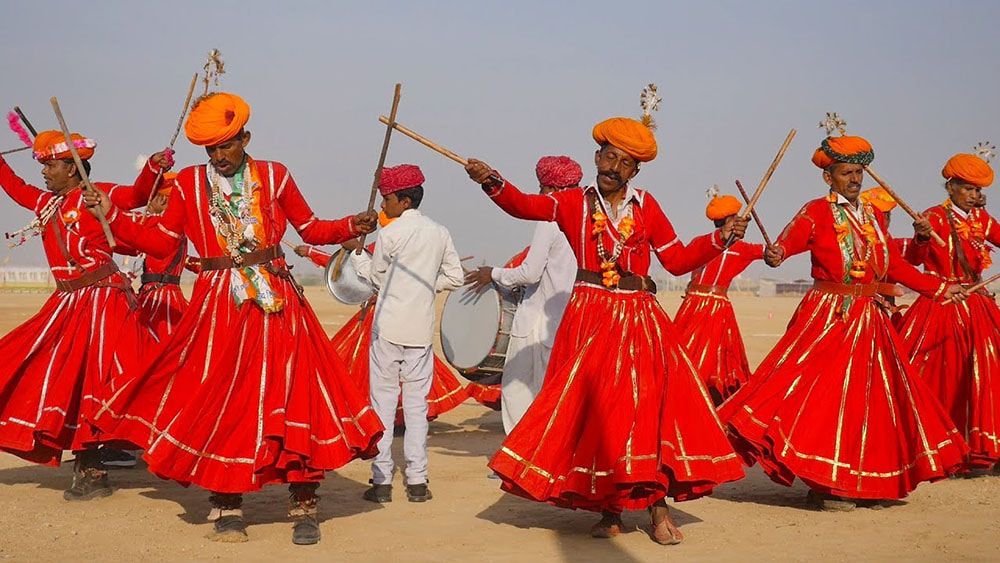The folk dance of Rajasthan stands as a testament to the rich cultural heritage of the state, offering a glimpse of its vibrant traditions and timeless customs. From the graceful waves of Ghoomar to the spirited movements of Kalbelia, each dance style reflects the unique identity and ethos of Rajasthan’s diverse communities.
As custodians of this intangible cultural heritage, it is important to preserve and promote these folk dances, to ensure that future generations continue to be mesmerized by the rhythm, tune, and spirit of Rajasthan.
Rajasthan, the land of vibrant colors, rich history, and captivating traditions, boasts a treasure trove of folk dances that reflect the spirit and ethos of its people.
Ghoomar dance – Folk dance of Rajasthan
Ghoomar, perhaps the most iconic of the folk dances of Rajasthan, is synonymous with grace, elegance, and feminine charm. Originating from the Bhil tribe, Ghoomar is performed by women who wear vibrant traditional attire, adorned with intricate jewellery. It is recognized as the state dance of Rajasthan.
This dance is characterized by graceful twirls, gentle swaying movements, and synchronized clapping accompanied by melodious folk songs. Ghoomar is not just a form of entertainment; It has deep cultural significance, symbolizing auspicious occasions such as weddings, festivals, and religious ceremonies.
Kalbelia dance – Folk dance of Rajasthan
Kalbelia dance is a famous folk dance of Rajasthan. This dance is performed by the snake charmer caste. This dance has amazing elasticity and speed, which hypnotizes the audience. This dance is performed by two women. men only play instruments
The lead dancers in the Kalbelia dance are usually women who dance and whirl in black ghagras imitating the movements of a snake. The dancers, dressed in black attire adorned with silver ornaments, enthrall the audience with their twists, turns, and acrobatics. Let’s do it.
Kalbelia dance is an expression of the traditional lifestyle of the Kalbelia community. It was included in the list of Intangible Cultural Heritage (ICH) of the United Nations Educational, Scientific and Cultural Organization (UNESCO) in the year 2010.
Bhavai dance – Folk dance of Rajasthan
Bhavai, an ancient folk dance form originating from the desert regions of Rajasthan, is a mesmerizing spectacle that is a combination of acrobatics, music, and storytelling. In this folk dance of Rajasthan, female dancers dance with 8 or 9 pitchers on their heads.
Traditionally performed by the Kamada community, Bhavai showcases the remarkable agility and balancing skills of the performers as they dance atop heaps of brass utensils or balance objects like swords and earthen pots on their heads.
Chari dance – Folk dance of Rajasthan
Chari dance, a traditional folk dance of Rajasthan, originated as a festive ritual performed by women during the harvest season.
The name of this dance is derived from ‘Chari’, during the performance of this famous dance of Rajasthan women dance with water pots on their heads, which is called Chari in the local language; Thus, it came to be known as Chari dance.
Puppet dance – Folk dance of Rajasthan
Rajasthan puppet dance is one of the important and ancient folk arts of Rajasthan state of India. The tribal people of Rajasthan have been performing this art since ancient times.
Any rural fair or religious festival in Rajasthan is not complete without puppet dance. In this dance, the puppeteer uses ballads to tell stories and these stories or tales of romance and chivalry are told with the movements of string puppets.

My self Dev Satish. I’m an Author and Founder of tourism-rajasthan.com. I’m from Rajasthan and If I talk about my Education then I’m Law Graduate. I love doing work that makes me happy, that’s why I love traveling. you will find Rajasthan travel ideas & tips on this blog.
